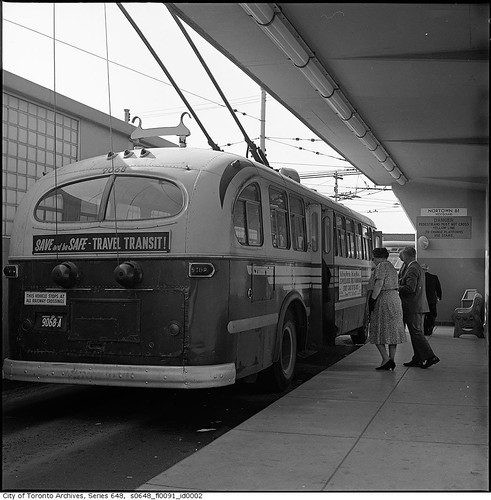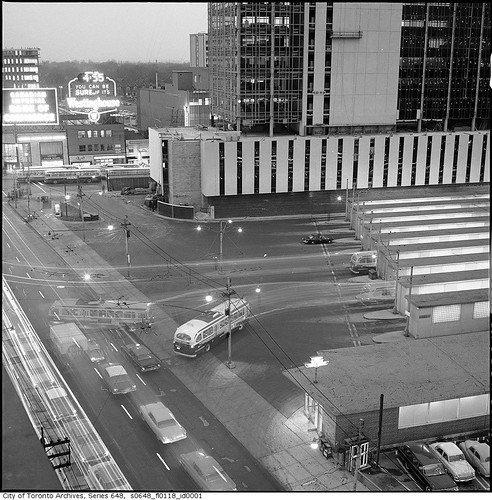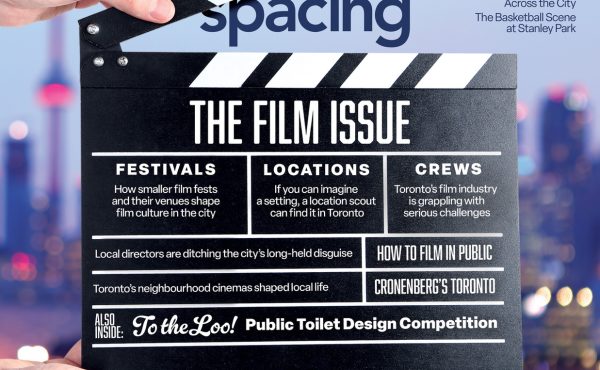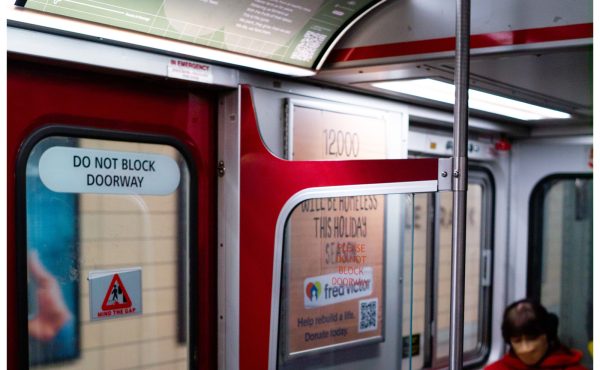In Saturday’s Headlines, Monica Warzecha posted a link to a Toronto Star article on the TTC’s problems with its hybrid diesel-electric bus fleet. The cleaner buses, built by Orion and subsidized by the federal government, never realized the promised diesel fuel savings, and now the large batteries required for the hybrids are giving out only 18 months, instead of the expected 5 year date. The TTC will go back to buying standard diesel buses, at least in the short term.
This follows another failed attempt at alternate fuel technology; compressed natural gas, or CNG. The CNG buses, first acquired by the TTC in the early 1990s, had distinctive domes on the roofs (the CNG tanks) and required a special fueling station at Wilson Garage. CNG buses could not enter certain bus terminals due to low overhead or dangers with CNG tanks in enclosed or underground terminals. There were promises that natural gas would be significantly cheaper than the TTC’s bulk diesel rates, and like the hybrids, were specially subsidized by senior governments. Some of the CNG buses, like the high-floor Orions on Dufferin, were converted to diesel; the unpopular 100% low floor Orion VIs (the ones with the door at the far rear) were scrapped.
From 1922 through 1927, and again from 1947 through 1993, Toronto utilized an alternate bus propulsion system with zero at-source pollutants and an excellent record – electric trolley buses. The early 1922 trolleys were an experiment on Merton Avenue and Mount Pleasant Road; they were replaced by an extension of the St. Clair Streetcar (later to be replaced again by trolley buses in 1976). In 1947, as part of its streetcar-replacement program, a network of trolley buses on medium-ridership routes on the west end (Lansdowne, Ossington, Annette, and Weston Road) was established; a separate division at Eglinton supplied buses on Avenue Road, Mount Pleasant and Yonge. After the subway extension to York Mills and then Finch, Yonge buses were re-assigned to Bay Street.
By the 1990s, the buses, which still had original equipment from the 1940s and 1950s, but entirely rebuilt in the early 1970s, needed replacement. As well, the overhead electric infrastructure was not well-maintained, and some of the routes, like Lansdowne, had declining ridership partly due to the deindustrialization of the west end. Like nearby Hamilton, the TTC opted to scrap the trolley buses by 1993 and go with the ill-fated CNGs. Leased Edmonton trolley buses (Edmonton itself just decided to scrap its system) made the last runs in 1993 on the 6 Bay and 4 Annette (now 26 Dupont).
While I doubt the TTC will seriously reconsider restoring its trolley bus network, it is one technology that has proven to work. There is potential though, especially if a new electric transit infrastructure is planned for the city with Transit City, where electric substations and wire can be shared. Dufferin, for example, with few branches and very high ridership, feels like one route where the the technology might make sense. However, with a few exceptions like Vancouver and San Francisco, the trend in North America since the 1950s has been to abandon fully-electric buses.
Top picture: #61 Nortown bus at Eglinton Station; City of Toronto Archives, Series 648, Fond 91, ID 002.
Bottom picture: Trolley buses entering Eglinton Station terminal; City of Toronto Archives, Series 648, Fond 118, ID 001.






28 comments
The trolley coach holds a very special place in my heart. One of my fondest memories of the TTC was sitting in a car at Weston Road & Albion and watching a Weston Road trolley make the turn onto Albion, turn onto the onramp and disappear beneath the bridge.
They may cost much more than a regular bus, as you point out the motor will keep on going long after the body has rusted away around it.
The one problem (like the current CLRV’s) is that the electronics within them age just like our computers. Usually they can be replaced, like the communication modules. The original were large boxes (1′ x 6″ x 3′) but are now small shoe box size.
Actually, the TTC is studying the feasibility of re-introducing trolley buses on its busiest bus routes that are not part of the Transit City LRT plan, as requested by Adam Giambrone in May. The report should be out by the end of the year.
Adam’s request is minuted on page 11, item 9 (“New Business”) here: http://www.ttc.ca/postings/gso-comrpt/documents/minute/f214/1897M-May_21-08.pdf
It’s a sad trend too.
The big obstacle stopping agencies from building trolley systems, is the initial capital cost. When the system is up and running, the savings are quite significant. Edmonton, like Toronto and Hamilton was short-sighted in deferring system maintenance. Vancouver, Seattle, SF, Boston, and Dayton maintained their systems, and look at the results.
The TTC is commissioning a report next year, but there is little hope it will be favourable.
The City of Edmonton is going to seriously regret scrapping their system. It seems that ETS is behind the curve, when it comes to Hybrid, and I have a feeling the city will regret their decision.
There was an article in the Star recently that stated that hybrid buses wear out in stop-and-go traffic. Of course, that’s Toronto’s traffic to a “T”. Even in suburbia when there’s a stop at every traffic light–and some others in between–the life and usefulness is shortened by the traffic pattern.
The implication is that hybrid vehicles might be better off as GO Transit vehicles which have longer runs between stops.
What amazes me is that Transit should have understood this before acquiring the fleet of hybrids. Or did they know and decide it was worth a try?
Torontonian:
I think you’ve pretty much got it backwards there.
Hybrid vehicles work best in stop-and-go traffic. That kind of situation allows them to make the most use of battery power, save fuel by shutting off the diesel engine, and recover power via regenerative braking.
When they’re driving long distances at high speeds, they essentially end up just running off the diesel engine, pretty much giving up any fuel savings. Unfortunately that’s what Toronto has been doing with them.
I can’t beleive those Eglinton bus bays are still there.
Much as some laud streetcars, in a city unwilling to make streetcar-rights-of-way the norm, a trolley bus has nothing but advantages: no tracks to lay, steerable around traffic, more easily removable when broken-down, no entering a lane of traffic and wondering if it will stop for me, and no tracks to take me down on my bike and put me under a truck at some intersection! Why aren’t we doing this?
The key point in the Star article on the hybrids, to me: “The remaining 2009 hybrids will be delivered with Chrysler’s new lithium-ion batteries rather than the lead-acid cells already in use on the TTC fleet.”
Lead-acid is what most standard car batteries use, relatively ancient technology; I’m a bit surprised they were implemented given the type of load a hybrid bus would see. Lithium makes far more sense.
I also note these were the Orion buses; over here in Waterloo Region we just started a trial of Nova hybrid buses. No word yet on performance, but it would be interesting to contrast the results.
The trolleybus has a huge drawback: The vehicle is half again as expensive as a diesel bus. For the cost of two trolleybuses, you could buy three diesel buses instead. On top of that, there is the expense of installing and maintaining the overhead wires — not a small cost.
Perhaps the lower energy costs outweigh the higher capital costs. The studies that have been done are open to conflicting interpretations. (For example, see http://bc.transport2000.ca/learning/etb/trolley_alert.html) Even if the long-term costs are comparable to diesel buses on an all-inclusive basis, the whopping up-front capital costs would surely give pause to any municipal administrator.
The latest trolleybus technology has just been placed in service in Zurich Switzerland. Built by Hess, they’re double-articulated, very quite (of course), very fast acceleration, 100% low-floor and very comfortable. I’ve just placed two photos of them on flickr – no idea how to link them to his submission or I would have done so. They’d be ideal for heavy routes here. Interestingly the model name is “lightram” and they’re aalmot as long as our ALRVs.
Sean: I found several photos from flickr here: http://flickr.com/search/?q=zurich+trolleybus&s=rec
If we still had trollybuses in Toronto, they could have evolved to a duel mode bus, electric and diesel, like shown on this video: http://ca.youtube.com/watch?v=r6-bEbd2ZTc .
Weren’t there complaints about how the wires messed up the views of buildings and heritage streetscapes? The pictures kindly linked above all show wires; there may be EMF issues too though what’s one more.
Certainly there’s an argument for trying to get the transit passengers loading/exiting at the side of the road for through traffic, but we also seem unable to think of having the ROW more at the curbside to share with bikes of course (somehow).
The TTC Report on trolley buses has now been put off until September 2009. There is a discussion on these long-delayed and unfinished TTC reports on Steve Munro’s site http://stevemunro.ca/
THose pix (I hate to admit) bring back memories for me of North York before the Subway. I do recall that the overhead wires being ugly was one of the reasons given for loosing the trollys.
I agree with Hamish that a curbside ROW is a concept that never seems to get the design attention it deserves. Are there any examples out there?
Whatever the TTC decides to buy, I hope they are more comfortable better designed than the horrible ones now on the road. THe other night a old GMC, if not at least an old one of some kind, was on the Symington route and what a pleasure that was to be in.
W K Lis said: “Weren’t there complaints about how the wires messed up the views of buildings and heritage streetscapes?”
What a lame excuse that was – perhaps we should bury all the hydro and telephone lines as well, then we could take down all those nasty poles and attach streetlights to nearby buildings. How about getting rid of fire hydrants, they’re a nuisance too, blocking parts of sidewalks as they do, although I think the Fire Department likes them (not to mention owners of burning buildings!). It always amazes me how some people want everything their way, too bad for those with other vies.
I have pleasant memories of riding the Kitchener Trolleys back in my teen years. They were oh so quiet (unlike streetcars which grind their wheels so often) and the ride was always smooth.
I found a pic of one of them and info at http://www.trainweb.org/elso/kit_puc.htm
For a comparison between electric and diesel, click on this link ( http://ca.youtube.com/watch?v=B9ZFQuSc0no )to a video of a dual-mode bus. When in electric mode, it is definitely quieter than when in diesel mode. (Diesel at beginning and end of the video.)
18 months to get a REPORT. 18 months in other transit systems would get you the actual trolleybuses… Steve Munro recently came across an TTC report which has been due for over 4 years!
I don’t remember ever riding trolley-buses in Toronto growing up, but I used to ride them in Cambridge, Mass. when I lived there a few years ago.
They were quiet, but the ride was far from smooth. It was always a jerky trip — sudden starts, sudden stops, people flying out of their seats, etc. Not comfortable!
Ah, how I miss that Nortown trolley bus. Quiet, smooth. One of my favourite childhood memories.
It might have been a little bit of a fantasy for Toronto to have continued to maintain every transit system known to man — subway, ALRT, LRT, streetcar, trolleybus, bus, commuter rail, ferry… (all we needed was a funicular for a complete set) — but it was still sad to see the trolleys go, especially since they made Mt. Pleasant, Bay and other streets feel a little bit more tied to their streetcar past.
SaskatoonMark — the Orion 7 hybrid buses have a similar cost premium compared to diesel buses, if not 50% higher then it’s close. The TTC got a federal subsidy to cover the premium so the capital cost worked out to be similar.
According to Wikipedia, SEPTA in Philly has now brought back trolleybuses to three of the five routes that used to use them. Would it ever make sense for Toronto to bring them back?
Interesting thought — with TransitCity, there will be more wire and possibly even right-of-ways all around town, in a series of disconnected segments. Yet Transit City has all kinds of shortcomings when it comes to connections. One could imagine trolleybuses running in conjunction with LRT trains along the rail routes, which would act as a trunk line, and then splitting off to the more suburban branches, which are appropriate for bus-level densities.
Aren’t exposed wires dangerous? Wasn’t the attempt to put out the fire on Queen St near Parliament exacerbated by all the streetcar wires? Come to think of it, didn’t overhead wires during the Great Fire of 1904 also hamper efforts to put out flames on upper floors, because ladders would get tangled in them? Isn’t fire safety the exact reason why we bury hydro and telephone lines?
Hydro and telephone wires are buried for the “opposite” reason, ice safety.
Vancouver runs trolley busses on most of their heavily used urban routes. They are fast, quiet, and powerful. They accelerate a lot faster than diesel busses and most of the drivers I have talked to much prefer them. The overhead wires can be ugly though.
http://upload.wikimedia.org/wikipedia/commons/thumb/7/73/Vancouver_trolley2101_050720.jpg/800px-Vancouver_trolley2101_050720.jpg
I’ve come from Europe, where trolley buses are quite popular. And with the modern controlling electronic equipment the trolley bus are among the most environment friendly vehicles. They are much more flexible than street cars, as they can always run around an obstacle (e.g. a stalled car) on the road, they are quiet, have very good dynamics (accelerate like a sporing car), and have zero emission. That is why a megapolis like Toronto should seriously consider trolley buses for its transit service. I really miss trolley buses here in Toronto.
As a resident of a former trolley city (Hamilton), I have to say that not only are trolleys cleaner, quieter and more traffic friendly, they are usually also lighter than say a CNG or Hybrid/electric cell vehicle. Ever notice how after only a couple of years after a major street has been resurfaced, that the curb lane near bus stops is quite often a mess with major indentations and ashphalt mounds thanks to the weight of these “alternative” vehicles? What is it costing these cities to repair these locations (when and if they do) thanks to abandoning the trolley? Yes the trolley may cause unwanted sight-line obstructions, but the overall cost of these “newer technology” vehicles has not proven itself in any way. I see more of these vehicles on the backs of tow trucks then I do cars…or left sitting for hours at the side of the road.
The trolley is the best way to go – and the more cities that require them, the more likely they will be cheaper to purchase. Several cities in Southern Ontario (I can’t recall which ones were all involved) but they made a joint purchase of (I think) hybrid buses and it saved these transit systems a more than substantial amount of tax-payers money.
Bring back the trolleys to Toronto and Hamilton!